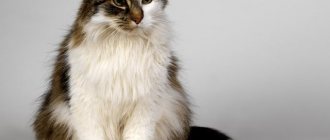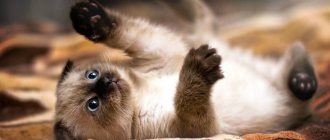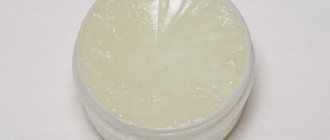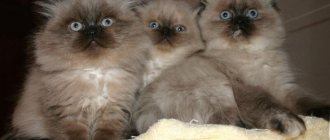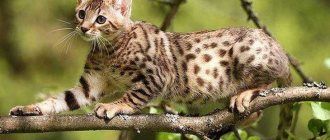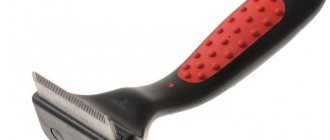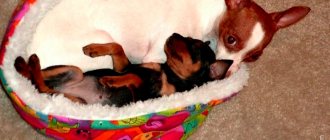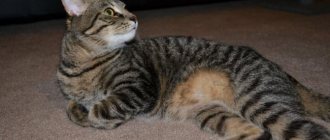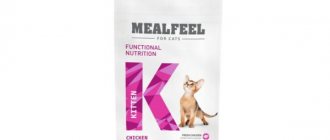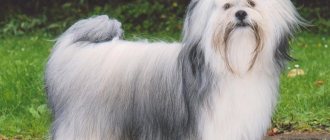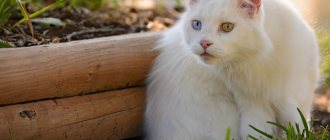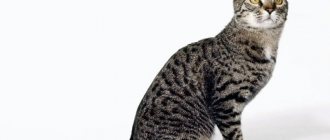Origin story
Neva Longhair is a very young breed.
Breeding of these cute cats with an unusual color and affectionate character began in the 80s of the 20th century, but to this day some felinological organizations stubbornly refuse to recognize the Neva Masquerade as a separate breed. The fact is that once upon a time “Neva masquerade” was the name given to the type of color of Siberian cats, and only quite recently they decided to separate them into an independent group with its own standard and characteristics. Their ancestors are Siberian, Persian and Siamese cats. In 1988, the famous breeder Olga Mironova brought a guest to the exhibition - a cat with an unusual pattern on her face. The judges appreciated the rare beauty.
A few years later - in 1992 - a standard was drawn up and a name was given to the new breed: Neva Masquerade (abbreviated as Nevak).
Moscow felinologists continued work on breeding the new breed. A dozen new colors have appeared, Neva Masquerade cats have become regular participants in international exhibitions and shows.
This breed is a real gem. And it's not just about external grace. Neva Masquerade cats can be kept by allergy sufferers who dream of having a pet. Neva cats have practically no antigens in their saliva; therefore, nothing gets on their fur when licked.
Tips for choosing a kitten
Neva Masquerade kittens are born completely white. Full color appears only after a year, but its makings can be seen at 3-4 months. It is better not to buy show pets before this age.
It is also recommended to opt for nurseries engaged in licensed breeding of the breed. In this case, the probability of deception is zero. Large institutions value their reputation and always provide a full package of documents when selling a kitten.
In addition to the veterinary passport and pedigree, be sure to check the cleanliness of the nursery itself. Meet the parents of your future pet to assess their appearance and habits. Remember that most qualities are inherited.
When choosing a baby, make sure there are no alarming symptoms. A wet nose, a brisk gait and shiny fur are a guarantee of the animal’s health.
Standards
| Standard | Description |
| Head | Trapezoid-shaped, wide and short. The forehead is low, the neck is strong and strong. The muzzle features are smooth |
| Ears | Small in size, set far apart, slightly tilted forward. The nose is medium in size, with a wide bridge. The cheekbones are smoothed, the jaw is clearly defined, the cheeks are plump. The chin is powerful and wide. |
| Eyes | Round, set slightly obliquely. Color of the iris: when young – bluish, over a year – blue. |
| Torso | Developed proportionally, medium length. The chest is wide, convex, the neck is strong and short, the muscles are well developed. Both hind and forelimbs are strong and slender. The paws are round, wide, with thick hair between the toes. |
| Tail | Medium length, hairy like a fox's. The tip is rounded. |
| Wool | Shiny, with thick undercoat. Doesn't let water through. In the head area and on the back it is of medium length, on the sides and on the tail it is long, growing in strands. On the hind legs there are fluffy soft “pants”, on the neck there is the same collar. In the summer, the coat loses some of its beauty, becomes duller, and lies tightly. In the winter season (like the ancestor of the native Siberian cat) it is thicker, with a richer texture. |
Feeding
Neva masquerade cats have absolutely no predisposition to gaining excess weight. But how and what to feed the animal is up to the owner to decide. If you choose dry food, choose high-quality food, no lower than premium class. Ideally, the food should be super premium.
If you choose natural feeding, remember that in this case the main component of the food should be meat, which is a natural source of taurine. The preferred meats are beef (lean), chicken and rabbit meat. Eating fermented milk products, vegetables, raw and stewed, and cereals will have a positive effect on your pet’s health.
Choose one type of feeding, do not mix dry food with natural products!
If you feed your pet a natural diet, it may be helpful to occasionally give him solid foods or treats to help him clean the soft plaque off his teeth.
Clean drinking water must be available within the pet's access area.
Weight by month
Males weigh up to 10 kg, females - 5-6. Height (height at withers) - 25-40 cm.
| Age | Cat | Cat |
| 1 month | 250-470 gr | 370-680 gr |
| 2 | 460-820 gr | 770-1450 gr |
| 3 | 0.9-1.5 kg | 1.4-2.3 kg |
| 4 | 1.6-2.3 kg | 1.8-3.6 kg |
| 5 | 2.1-3.3 kg | 2.3-4.2 kg |
| 6 | 2.5-3.6 kg | 2.9-5.6 kg |
| 8 | 3.1-4.4 kg | 3.5-6.4 kg |
| 10 | 3.2-4.6 eg | 5.1-7.1 kg |
| 1 year | 3.4-5.4 kg | 5.8-7.7 kg |
| 2 and older | 3.6-6.5 kg | 7.5-9 kg |
Nail trimming
The Neva Masquerade cat's claws need to be trimmed as the transparent part grows back. For cutting, you need to purchase a special nail clipper. If during the procedure you accidentally cut your claw until it bleeds, you must immediately disinfect it with peroxide and cauterize it with iodine. There is no need for a haircut if the cat uses a scratching post.
To protect your hands and furniture from scratches, you can purchase special anti-scratch caps. Although there is an opinion that they cause harm and discomfort to the cat, this is not at all true. Properly worn anti-scratch guards do not interfere with the function and growth of the claw. They need to be changed as it grows. The nails will still need to be trimmed once a month. Contraindication: allergy to the glue used to attach the caps to the claw.
Color-matched anti-scratch pads look very unusual and decorate the cat.
Colors
There are several color options:
- Seal-point. The body is light in color, the muzzle and tail are darker. There are dark “socks” on the paws.
- Seal tabby point. The coat is ivory-colored, with brown stripes on the body.
- Red-point (red-point). Red points on the coat.
- Blue-point (blue-point). Color with blue shades of fur.
- Tortie-point (tortoiseshell color). Tricolor cats (in 95% of cases these are females).
According to the rules, the contrast between the main shade of the coat and the brown areas should be clearly expressed, and the dark areas should have the same color intensity. The only color that is not recognized by the standard is chocolate lilac.
In the photo there is a Neva Masquerade cat of popular colors: blue point, seal point and red point.
Newborn kittens have white fur, but it darkens quite quickly. The reason for this phenomenon is the color gene. It is sensitive to temperature changes, and when the temperature drops, pigmentation begins to enter the hair structure.
The disadvantages of the breed are:
- Long undercoat or lack thereof;
- Wool without shine, matted or with bald spots;
- Narrow, sparsely pubescent tail, with kinks or bumps;
- Deep-set or small eyes;
- Ears of disproportionate size with weak pubescence;
- Elongated muzzle with narrow cheekbones;
- Fragile bones, too small paws, long and thin neck, thin and long limbs.
You cannot “breed” a Neva Masquerade cat with other breeds. The animal matures quite early: at 9-10 months.
Health of the Neva Masquerade
Nevaks can boast of strong immunity. The Neva Masquerade Dancers owe their health to the Siberians. These aboriginal cats were hardened by nature, and the addition of a new color did not bring about critical changes.
To increase average life expectancy, it is enough to follow standard preventive measures. Get your cat vaccinated and treated for parasites every year. Infections, helminths and fleas affect even those who live in an apartment all their lives. Also visit your veterinarian regularly to identify possible hidden pathology at an early stage.
Possible diseases
Due to the long hair, bezoars, that is, hairballs, quickly accumulate in the cat’s stomach. Usually animals regurgitate them on their own, but sometimes their quantity is too large. This can lead to intestinal blockage and even rupture. For prevention purposes, it is recommended to give your pet a special paste that helps remove hairs.
Among hereditary diseases, hypertrophic cardiomyopathy is worth noting. In a sick animal, blood stagnates in the pulmonary vessels. This is accompanied by increased heart rate and fainting, but sometimes the pathology is asymptomatic. The milder the symptoms, the more favorable the prognosis. Timely treatment helps to avoid complications and maintain quality of life.
Reproductive health
Pregnancy and childbirth in Nevaks are easy, so breeders often help the future offspring to appear at home. Most often, a cat gives birth on the 64th day after mating 3-4 kittens.
The first mating is carried out no earlier than the third heat. This reduces the likelihood of the death of a young female and the birth of a weak litter. It is also not recommended to untie cats immediately after puberty. At 9 months they begin to show interest in the opposite sex, but are not yet able to participate in breeding. When mating with such a partner, misfires often occur, so fertilization does not occur even after several meetings.
For pets not involved in breeding, it is recommended to undergo castration or sterilization. The first operation is more effective. It not only eliminates the ability to reproduce, but also suppresses sexual desire. The operated pet ceases to suffer from the opposite sex and receives protection from a number of dangerous diseases.
Character and behavior
The first word that comes to mind when looking at the Neva masquerade cat is nobility. Self-esteem is the most striking feature of the fluffy beauty with heavenly eyes. She clearly divides people into friends and strangers. Our own - i.e. family members can treat her more familiarly, but strangers will not allow this.
Neva Masquerade cats treat all family members warmly: both adults and children of all ages. They are unobtrusive and not loud, they clearly know when to voice and when to be quiet (for example, at night), they know how to listen and calm with their gentle purring.
They are calm and somewhat phlegmatic, but they also don’t mind playing. Be sure to buy several toys of different sizes - your little one will happily run around with a ball and hunt a toy mouse. He is extremely curious: any even more or less significant event in the house will not go unnoticed by him.
Does your pet like to go for walks?
HomebodyWalking on the street
It can live in an apartment or in a private house, and the latter option is good because you can often go for a walk with your pet in the yard. Neva Masquerade cats are not afraid of street noise and other animals, but begin to explore the world around them with great diligence and try to establish contact with neighboring cats and dogs. They get along with both the first and the second, and do not enter into fights for leadership. But they show aggression towards birds, rodents and fish and begin to hunt.
A newborn kitten should be immediately accustomed to order in the house, otherwise problems will arise in the future. Scratch claws only on a scratching post, sleep exclusively on your own separate bed, eat in the kitchen from your own bowl, go to the toilet in a litter box (we recommend reading How to train a kitten to use a litter box?) - these are the basic rules to which no exceptions are made.
This is one of the bravest breeds: the Nevak, seeing a threat to its offspring or owner, is not afraid to engage in a fight with an opponent much larger than itself. An extreme situation for a newbie is not a reason to panic.
There are several nurseries in Russia where you can buy yourself a newborn baby. There is an option to turn to private breeders - there are also many of them. The cost of a kitten of the Pet and Brie classes ranges from 12 to 30,000 rubles. A show-class baby costs even more - from 35,000 rubles. Females are valued higher than males, as is tortoiseshell.
Characteristics of a masquerade cat
The character of a masquerade cat can easily be called golden. These are very calm animals that know how to show a sense of tact and unobtrusiveness. Neva beauties love to show off their chic by walking in front of their owner. However, if attention is not paid to them, they do not insist on their company and patiently wait for a more favorable moment to communicate with a person.
The Neva Masquerade cat is very attached to its owner and family members. They are the ones who come first among all other people. Guests who visit the house can only enjoy the contemplation of the handsome man, since they are strangers to the newcomers.
The Neva kitten is a true friend for children . Even in adulthood, pets can show moderate mobility and willingly join in games. For a family with children, such a four-legged creature is ideal. A cat will never scratch a child; on the contrary, it will do its best to create a comfortable company for him.
global $ads_google; //data-ad-slot=”2475549904″ $ads_google = empty($ads_google) ? false : true; ?> if ($ads_google == false) {?> $ads_google = true; ?> } ?>
Thanks to its high intellectual abilities, the Neva Masquerade Dog quickly adapts to the home, is easy to train, responds to its name and is accustomed to the litter box. In addition, these domestic cats cannot be called vindictive. Even having had an unfavorable experience with humans or other animals, they will not take revenge. But still, sometimes cats can be stubborn in nature. For greater contact and mutual understanding, the owner needs to build a partnership with his friend, avoiding insults and ignoring the pet.
If fellow animals appear in the house, then the cats gladly accept them into their society. They are quite tolerant not only of dogs, but also of the feathered inhabitants of the apartment.
Owners of purebred cats leave only positive reviews about the character of this beautiful breed.
Care instructions
Wool
The luxurious wool of the Nevaka is a headache for owners, especially during molting periods (from September to November and February to April). On normal days, the cat should be brushed every week using a slicker brush, a brush with natural bristles and a wide-tooth comb. During molting, bathe daily, and also weekly.
Human shampoos and gels cannot be used. Special ones (“From tangles” Phytoelita, “Doctor ZOO”, “Detangling Celandine” Ecoprom) do not cause allergies or skin irritation, and they are safe for the cat’s stomach (if the cat accidentally swallows the drug).
The resulting tangles are almost impossible to untangle. The only way to get rid of them is to cut them off with nail scissors.
Ears
Clean your ears once a month by soaking a cotton swab in olive or vegetable oil.
Eyes
The eyes are wiped with a cotton swab dipped in strong warm tea, chlorhexidine or, at worst, boiled water.
Teeth
Teeth are brushed once a week using a cat toothbrush and toothpaste (Trixie, Beaphar Toothpaste, Hartz).
Expert opinion
Dusheba Vera Ivanovna
In 2010, she graduated from the Moscow State Academy of Veterinary Medicine named after K.I. Scriabin with honors, specializing in veterinary medicine. I regularly attend veterinary conferences, congresses, and webinars.
It is too early to adopt a kitten under 3 months: in the first months he still really needs his mother. Therefore, do not give in to the breeder’s persuasion to pick up the kitten in a month or two. The veterinary passport must indicate that the little one has been dewormed and given all age-appropriate vaccinations. The kitten should not run away from you, run away from your hands, or flinch from extraneous sounds or your movements. Otherwise, it will mean that he is growing up in uncomfortable conditions, which negatively affects his character.
In the photo there is a cat of the Nevskaya Masquerade breed
Education of the Neva Masquerade
Training Nevaks is very easy. The main thing is to outline the rules of behavior immediately after the kitten appears. Teaching prohibition commands should not be accompanied by periodic relaxations. If you have forbidden something to your pet, remember that it is forever.
Timely education helps to wean children from leaving marks and damaging furniture. Cats quickly get used to the toilet and can even learn a few simple tricks. The easiest command for them is “fetch”, since the game form of training and imitation of hunting fuel interest in the process.
With more ordinary things, the owner may encounter stubbornness. Here you will have to work on your relationship with the animal. Cats rarely overstep themselves in an attempt to please a person, so avoid conflicts so as not to spoil your reputation.
Catering
The health of your pet largely depends on a properly selected menu and the quality of products (or food). So what should you feed the Neva Masquerade?
Natural products
Natural nutrition has several nuances:
- Firstly, you cannot feed the nevak what you eat yourself: dumplings, spicy and salty soups, fried potatoes and other “delicacies”. The cat’s gastrointestinal tract will simply “fly” and you will have to treat it for indigestion, cope with diarrhea and other “delights” of poor nutrition.
- Secondly, many foods are contraindicated for cats. Smoked, sweet, salty, flour, baked goods, juices and carbonated water, dog food and human canned food, potatoes, citrus fruits, sugar and salt, seasonings and ketchups, river fish, pork and fatty meats - the list is huge! Do not give bones under any circumstances - even small ones can get stuck in the throat, scratch the mucous membrane, and ultimately pierce the stomach. Lard and tripe are also prohibited, as are sausages, sausages, potatoes, eggplants, and almost all fruits (with the exception of melons, apples and bananas).
- Thirdly, you can’t feed your cat! This leads to the development of obesity, followed by associated diseases (such as diabetes, heart problems, etc.). Cats older than six months eat 2 times a day, from 4 to 6 months - 3-4 times a day, under 4 months - 5-6.
The following products should be present in a cat's diet:
- Lean meat: veal, turkey, rabbit, beef (every day);
- Sea fish: hake, trout, salmon, flounder (no more than once a week);
- By-products: liver, kidneys, hearts, ventricles (2-3 times a week);
- Cereals: buckwheat, pearl barley, barley, oatmeal, rice, millet (every day);
- Vegetables: pumpkin, carrots, zucchini, green salad, parsley, dill, green beans, green peas (every day);
- Dairy products: yoghurts without dyes and harmful additives, low-fat sour cream, cottage cheese, fermented baked milk, kefir, yogurt (every other day);
- Oils: vegetable, olive or flaxseed;
- Purified water at room temperature.
Recommended food
Many breeders choose dry and wet food of the holistic and super-premium classes: they are made from high-quality products, undergo all the necessary treatment against parasites and pathogens, and contain a complex of vitamins and minerals necessary for the animal.
Holistic feed: AATU, Farmina N&D, Nutram.
Super-premium food: 1st Choice, Airi, Brooksfield, Landor.
Below are recommended holistic foods. Links with the names of the food are clickable, on them you can, within our website, get acquainted with the descriptions of the food and read reviews from owners of cats of the Neva Masquerade breed.
| Holistic | Holistic | Super premium |
| Jaguar | Riverwood | Josera |
Cost of a kitten
You should purchase a Neva Masquerade pet from large nurseries or from well-established breeders who breed and sell these cats. There are quite strong differences in the cost of kittens due to gender, class, rarity of color and other factors.
Prices also vary from region to region; in large cities, purchasing a cat will most likely be more expensive, this depends on the pricing policy of the cattery.
A cat without a decent pedigree will cost 2-5 thousand rubles (sometimes prices reach 10). You can buy a show class kitten for 25 or more, breed class costs from 15, pet class – from 5-7.
Diseases
The Neva masquerade cat has a strong immune system. There are quite a lot of long-livers among individuals of this breed, with a third having crossed the 20-year mark. But there are a number of hereditary diseases that the owner should be aware of.
Hypertrophic cardiomyopathy is a thickening of the heart wall. This pathology is not detected in the early stages, but symptoms can be gradually tracked. The cat becomes lethargic, runs and jumps less, and develops shortness of breath and wheezing. The disease cannot be cured, but supportive therapy will help extend the pet’s life for several years.
In cats over 8 years of age, kidney failure is often diagnosed. A special diet, therapy and control by the owner will help support the body.
Vaccinations are mandatory, even if your cat does not go outside. Caused by such terrible diseases as calcivirosis, rhinotracheitis, panleukopenia, they can enter the house on your hands, on the soles of shoes or with outer clothing. Without vaccinations, these diseases most often result in the death of animals.
The problem with many cats is hairs getting into their stomachs. They roll into balls - bezoars, are not digested, and can cause digestive system upset. In order for these balls to come out, the cat causes a vomiting reaction by eating sprouted oats or wheat. Therefore, do not forget to plant these cereals at home. Additionally, you can give a special paste.
In the photo there are kittens of the Neva Masquerade breed
Care and maintenance of the Neva cat breed
Standard hygiene procedures are required for a Neva Masquerade cat They consist of caring for the coat, ears and eyes. The animal needs to be combed and bathed regularly. To do this, it is recommended to purchase special combs, slickers and detergents.
Since tangles form weakly in the coat, combing out is not difficult. However, special care should be taken with the tail. On this part of the body, hairs are pulled out very easily, but restoration is difficult and takes a long time.
What to feed a Neva masquerade kitten at 2 months
Food for a slender cat must include meat products. Lean chicken, beef, rabbit, and offal are suitable. The only exception in the diet for the Neva cat is the liver, since its excess can cause changes in color. Other useful products include fish, cottage cheese, milk, and sour cream. A Neva Masquerade kitten will grow up strong and healthy if you use ready-made dry and canned premium food instead of home feeding.
In general, caring for the Neva breed is quite simple.
Diseases of Neva Masquerade breed cats
The natural origin of the breed provided St. Petersburg cats with very good health. They have virtually no diseases or congenital anomalies. Only rarely can an older kitten develop hypertrophic cardiomyopathy.
Otherwise, the masquerade cat breed is characterized by good health indicators, which must be maintained with regular vaccinations and periodic veterinary examinations.
In favorable conditions of care, maintenance and feeding, Neva masquerade cats live up to 20 years.
Sterilized Neva cats, as a rule, live a little longer than those experiencing estrus, mating and pregnancy.
Flaws
If you want to purchase a kitten in order to breed, breed, or participate in exhibitions with it, carefully check that none of the characteristics deviate from the standard.
The disadvantages of the breed are its small size, lack of weight, long or too narrow muzzle, nose resembling a Persian or, conversely, too straight. Small eyes, short or too long legs or tail. The absence of tufts of hair on the pads of the paws - with this characteristic, the cat will also not be able to take part in exhibitions.
If you purchased a smooth-haired cat, then it is not a purebred, most likely it is a mixed breed or even a “mongrel”. A true Nevak can only be long-haired, with a thick and shiny coat.
